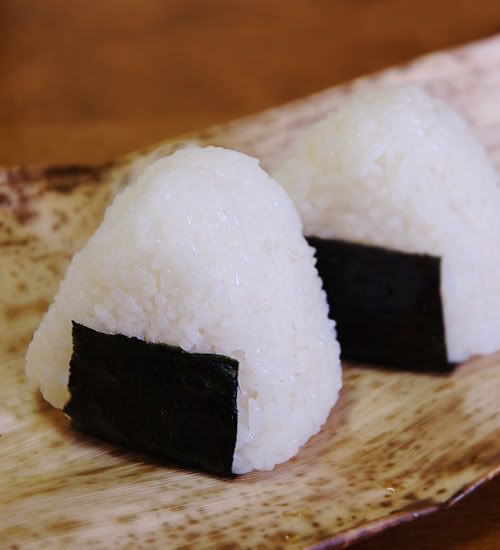 |
| Not my photo. |
I’ve been trying to make good onigiri for a while, and I feel confident enough to make a post about it. I am by no means an expert, but I’m sharing what I know, as usual.
Onigiri, or more commonly, riceballs are a (very portable) type of Japanese food made using… you guessed it, rice! Typically, they have a triangular shape, but they aren’t limited to that. In dekoben culture, you will often see alternately shaped onigiri. So far, I’ve seen Totoro, sheep, and panda onigiri, so you’re only limited by your imagination. Since I’m a novice, and I only have a triangular press, I’m sticking to triangular and spherical onigiri.
Onigiri CANNOT, repeat CANNOT, be made using long grain white rice. It’s not sticky enough when cooked properly, and when it is sticky it’s just a pile of mush. In order to make onigiri, you need to have short or medium grain rice. You do not use sushi rice because onigiri isn’t sushi.
Onigiri can simply be lightly salted and eaten plain, but it’s more popular to have fillings. Popular Japanese fillings are umeboshi (pickled plum), tarako, or salted salmon. In actuality, anything can be used as filling as long as it’s fairly salty or sour, and tastes good with rice. Right now, I’ve been using SPAM, since I was inspired by Hawaiian SPAM musubi. If you fry it on the stove with a mixture of soy sauce and sugar, then ‘dry’ it (oily fillings make the onigiri fall apart), it tastes pretty good.
It doesn’t spoil when I take it to school hours later, because
After they are filled (or not), you wrap the onigiri in a sheet of dried seaweed. The seaweed, called nori, makes it easier to hold the sticky onigiri when eating. It’s a bit of an acquired taste, if you aren’t used to it, but I never eat my onigiri without it now. Only put the nori on the onigiri when you are eating it immediately. If you don’t, the nori will get soggy and mushy. I haven’t eaten it that way myself, but I don’t think it’s very pleasant.
Things to Have On Hand:
Short or medium grain white rice
Rice Paddle (shamoji)
Nori
Rice Measuring cup
Rice Cooker (personal preference; you can do it on the stove or microwave, too)
Onigiri Press (Easier than the other methods.
Something for filling (I'm using SPAM)
Plastic Wrap
+Wash your hands. I don’t know what’s on your hands, but you don’t want it in your food.
+Measure out the amount of rice you’re going to use. Add cold water to wash the rice. Fill it up so that it’s higher than the amount of rice in the bowl. Using your hand, swish the rice around. The water should become cloudy. Drain the rice and repeat until the water runs clear. Washing the rice beforehand makes it a little stickier.
+Add the appropriate amount of water for the rice. The amount varies, but I believe it is 2 1 cup of water, per rice measuring cup of rice. Let the rice soak to make it even stickier. Let it sit for 10-20 minutes. If you’re using a rice cooker, I usually put the pan inside at this point without plugging it in.
+After the rice sits, I plug it up and turn it on. After it cooks, I lightly stir it using the shamoji and add a little salt.
+For Plain Onigiri: If you have an onigiri press like I do, wet it, then scoop the rice in and press down hard using the “press” part. While holding down the “press”, pull the outer part up and off. If you don't have an onigiri press, when the rice cools a little (warm, not cold), wet your hands, and mold the rice into a triangle shape. You should have a nicely shaped onigiri!
+For filled Onigiri:
When putting filling in the onigiri, simply add a layer of rice in the press, make a small indent and add the filling, then add more rice and follow the above method. If you’re doing it by hand, make a small indent before shaping the rice and add the filling, covering it when you mold the rice.
Add nori, or wrap it in plastic wrap to save for later. You can even cut the nori into shapes to decorate your onigiri!
Next time I make some, I'll add pictures of the process.
No comments:
Post a Comment
Comments are moderated to ensure no one's comment is overlooked. ^^